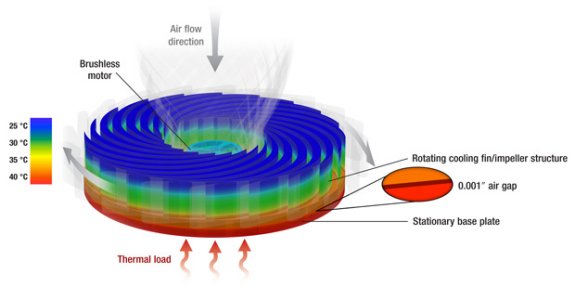
Posted on Monday, July 11 2011 @ 23:08 CEST by Thomas De Maesschalck
The Tech Report
writes Sandia National Laboratories has designed a new type of CPU cooler with an "Air Bearing Heat Exchanger". Interestingly, the cooler lacks a fan and rotates the heatsink itself at a few thousand RPM to generate a centrifugal pumping effect that shrinks the boundary layer between the cooling fins and the air by a factor of 10. These coolers promise much lower profiles than traditional CPU coolers while offering similar performance and noise levels. I'm unsure of how well it will work, but a rotating heatsink will most definitely look awesome!
According to Sandia, spinning the specially designed heatsink at "a few thousand RPM" generates a centrifugal pumping effect that shrinks the boundary layer between the cooling fins and the air by a factor of 10. A lengthy and equation-filled whitepaper (PDF) on the technology describes this layer of dead air as the "primary physical limitation to performance" of traditional air coolers. That same whitepaper talks up the noise-reducing potential of this new approach to cooling, and it points out that the spinning fins won't accumulate dust. Sweet!
Although Sandia's press release focuses more on potential applications for data centers, the technology is said to be suitable for laptops and PCs. In fact, high-performance gaming rigs are mentioned specifically. It's even more encouraging to see the design described as "simple, rugged, and cost-competitive."
Exact details on how it works can be found in this
whitepaper (PDF).

